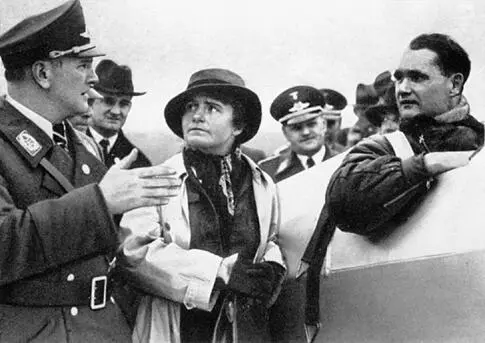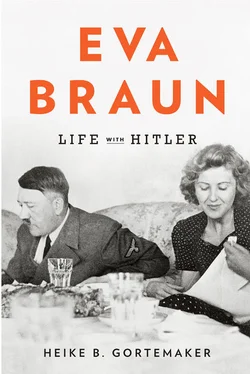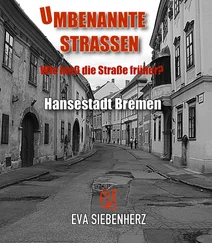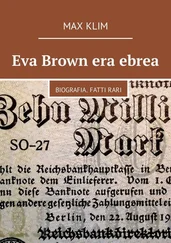Ilse Hess—the third potential Nazi “First Lady”—was an exception among the wives of the leading National Socialists. Unlike the others, she was among the earliest supporters of the National Socialist movement and was, as she said herself, “a National Socialist from inner conviction.” 52A doctor’s daughter from Berlin, she was preparing for her exams in Munich when she met Rudolf Hess in the small Pension von Schildberg in Schwabing, in April 1920. He was studying economics, history, and political science at the time, and he brought her along to a so-called discussion evening run by the NSDAP as early as spring 1920, probably June 1. Adolf Hitler, whom she didn’t yet know, discussed in detail the Party’s goals in a small back room and cast his spell over them both. Hitler had spoken in a language, Ilse Hess later admitted, that she “craved,” because he “had the courage, for the first time since 1918,” to “talk about Germany.” 53Like many women of her generation, especially as the daughter of a Prussian medical officer from the First Guards Regiment in Potsdam, she had been overwhelmed by the trauma of unexpectedly losing the First World War and the feeling of humiliation resulting from the Versailles Treaty, which had “vilified the German People before all other Peoples.” 54
Hitler, though, was starting to make a name for himself in the Bavarian capital city for his anti-Semitic agitations in mass rallies against the “Versailles diktat.” As propagandist for the NSDAP—he became its leader only in the following year, on July 29, 1921—he appeared once or twice a week in the city’s beer cellars. While Rudolf Hess joined the NSDAP “immediately” after their joint attendance at the “discussion evening,” Ilse Pröhl, as she was called until her marriage, first became Hess’s “political secretary” and then, in late 1920, as a student of German and library science at the Ludwig Maximilian University, his “secretary, adjutant, and staff” in one. Hess was already, as he wrote in a letter to his parents on September 14, in “almost daily” contact with Hitler. And Ilse Pröhl, as she retrospectively admitted in 1955, contributed the most to her future husband’s “nearly magical” bond with Hitler. 55Finally, in 1921, she joined the NSDAP herself and wrote in a letter to her former grammar school teacher:
For there is a movement starting here in Munich now, which strongly attracts all the young, strong, and still thoroughly healthy forces…. It is called the National Socialist German Workers’ Party. It stands—to be right upfront about it—completely on the soil of the German People, or, to put it in the clean and plain and negative terms appropriate to the movement: we are anti-Semites. Consistently, rigorously, without exceptions! The two basic pillars of our movement—national, and social—are anchored in the meaning of this anti-Semitism. Love of country and of our people above all private interests. 56
The twenty-year-old Ilse Pröhl here formulated, unambiguously and conclusively, her belief in the fundamental ethos of a party that at that point was only one of many Populist-nationalist groups in Munich. And its anti-Semitism presented, as her letter makes clear, a foundation of the Nazi ideology with which she had no problem. She and Rudolf Hess, convinced that striving for socialism on a national basis included “in an entirely intrinsic way the struggle against Judaism,” made their support of Hitler, whom they called “the Tribune,” their raison d’être. Ilse Hess, who after the war insisted that she had been “always passive, as a woman,” was thus in truth an activist from the beginning. Her letters, which are now available to researchers, offer a glimpse that is otherwise hard to come by into the world of the wives of the Nazi leaders and their ideas at the time.

Ilse Hess at the side of her husband, Rudolf Hess, after his victory in the air race around the Zugspitze on March 10, 1934. To the left, Reich Air Sports Leader Bruno Loerzer; in the background, Colonel Erhard Milch, State Secretary in Göring’s Ministry of Air Travel. (Illustration Credit 5.3)
When Hitler was imprisoned in Landsberg after the failed Beer Hall Putsch of November 8–9, 1923—in which Hess had taken part as well—and started writing his book Mein Kampf (My Struggle), Ilse Pröhl was once again there to help him. The youthfully romantic student sent her boyfriend Hess, who was with Hitler in Landsberg prison, Friedrich Hölderlin’s Elegies as inspiration for Hitler. Hitler, though, apparently could make little headway with Hölderlin’s poetry, with its oscillations between hope and lament conjuring up the certainty of mankind’s renewal. Hitler liked the “type area,” Hess reported, but “he did not have much understanding of the elegies.” 57Ilse Pröhl also worked with Josef Stolzing-Cerny, the editor and cultural critic of the Völkischer Beobachter , as a reader of Hitler’s manuscript, and helped with the final version in 1925. It is unlikely, in contrast, that Rudolf Hess took part. Hitler assigned him to work on the corrections, but Hess apparently passed that work along to his girlfriend. 58
After her marriage to Hess on December 20, 1927—he had meantime become Hitler’s “private secretary” and one of his closest friends—Ilse also corresponded with publishers and Party leaders and their wives, including the Goebbels and Göring families. The correspondence gives the impression of a very familiar, cooperative relationship, with, for example, gifts exchanged on holidays. Hess was the eccentric minister without portfolio, subordinate only to Hitler himself, and the “Deputy Führer” in Party affairs, while his wife, Ilse Hess, worked to maintain relationships and mediate any conflicts that arose. For example, she wrote to Heinrich Himmler, who took over the office of Munich chief of police in 1933, with the salutation “Most honored of all Chiefs of Police!” and continued in a humorously cryptic tone that he had “the surely praiseworthy habit” of “monitoring enemies of the Fatherland.” But why was he also keeping “upstanding ministers” under surveillance and pestering them with “ridiculous surveillance noises on the telephone”? If he was not the “wrongdoer” himself, perhaps he might be able to “look into what she suspected” was happening. 59
Unlike Emmy Göring, Ilse Hess was also in contact with Eva Braun. It cannot be determined when they met, or whether their connection included personal meetings or took place entirely by letter. It is certain, though, that Hitler’s girlfriend was among those who received Christmas presents from Ilse Hess, for which Eva Braun gave warm thanks in a letter addressed “Dear Madam.” 60Like the other “First Ladies of the Third Reich,” Ilse Hess also played a public role, admittedly a smaller one than that played by Magda Goebbels. Pictures of Ilse Hess and her son Wolf Rüdiger Hess, Hitler’s godson, appeared in newspapers such as the high-circulation Berliner Illustrirte Zeitung. And until her husband flew to Scotland in a fighter plane on a wayward mission on May 10, 1941, “Madame Reich Minister” employed no fewer than two secretaries of her own to keep the flood of correspondence under control. Even after Hess’s mission, as “apparently persona non grata,” she maintained contacts and remained, as she told the writer Hans Grimm in November 1944, “unswervingly true to the law… according to which we lined up under the Führer’s banner in 1920.” Until the very end, the idea that her husband “would stand once more at the Führer’s side as one of his most faithful followers” remained for her a “wonderful dream.” 61
Читать дальше













